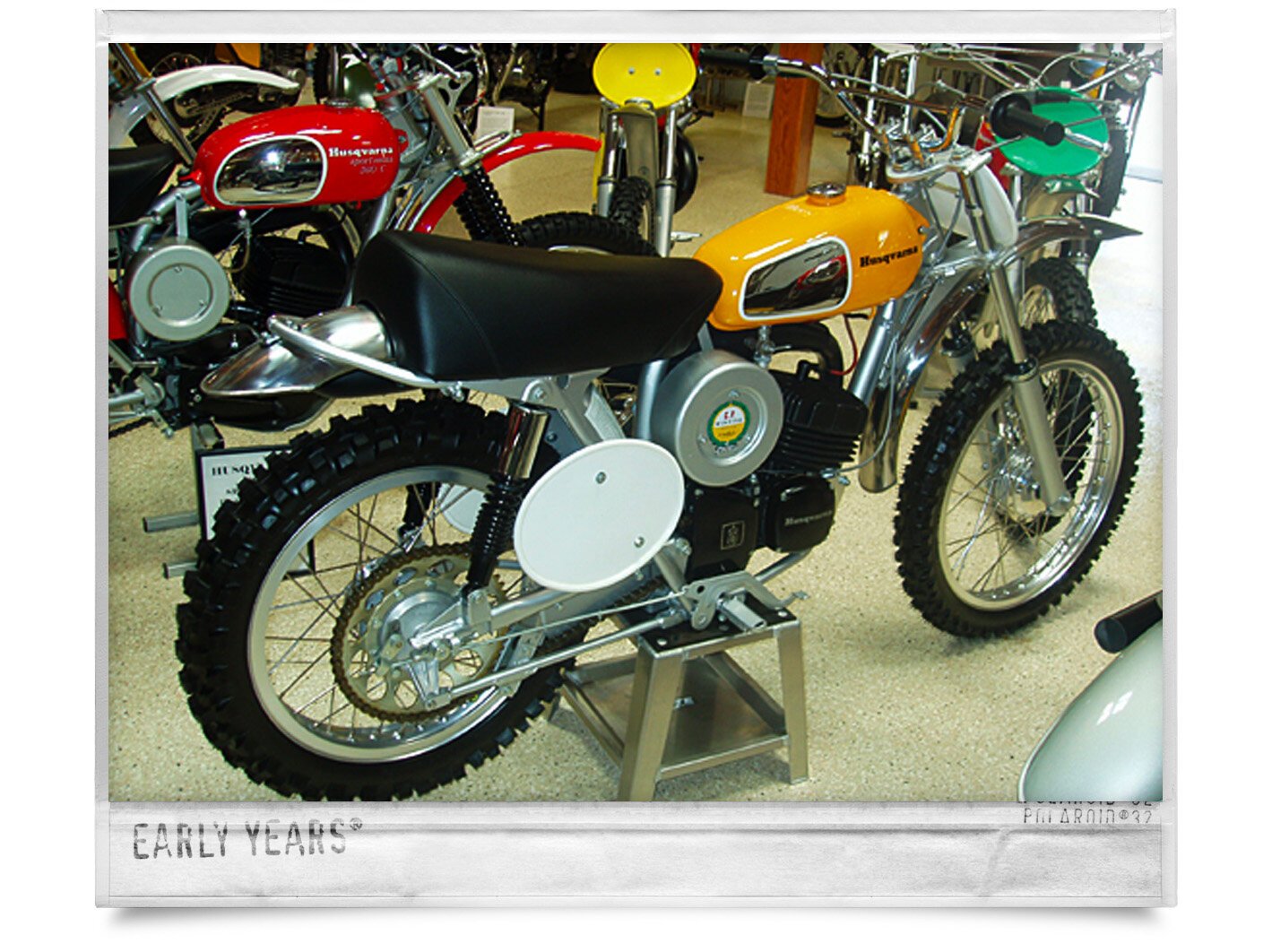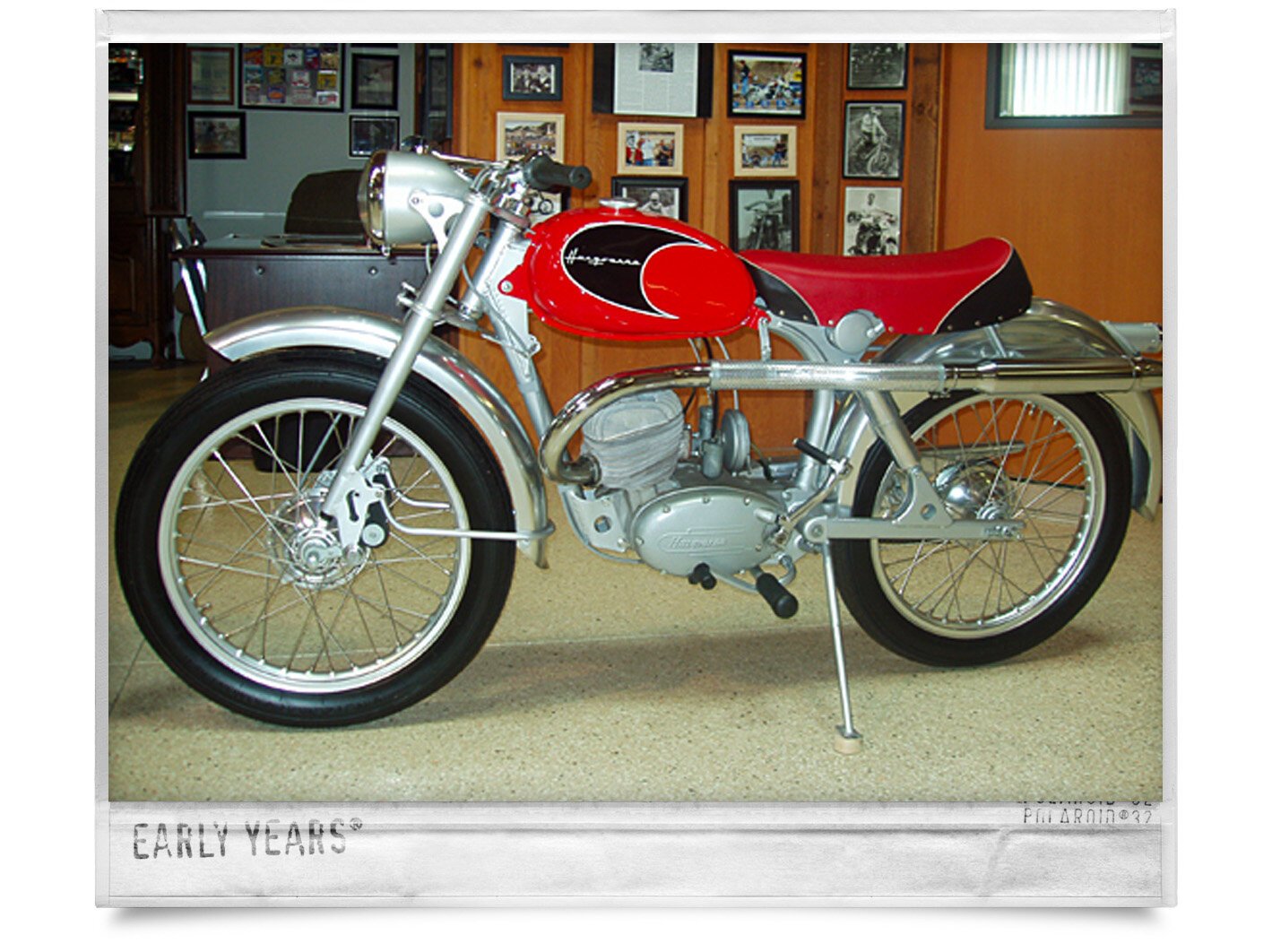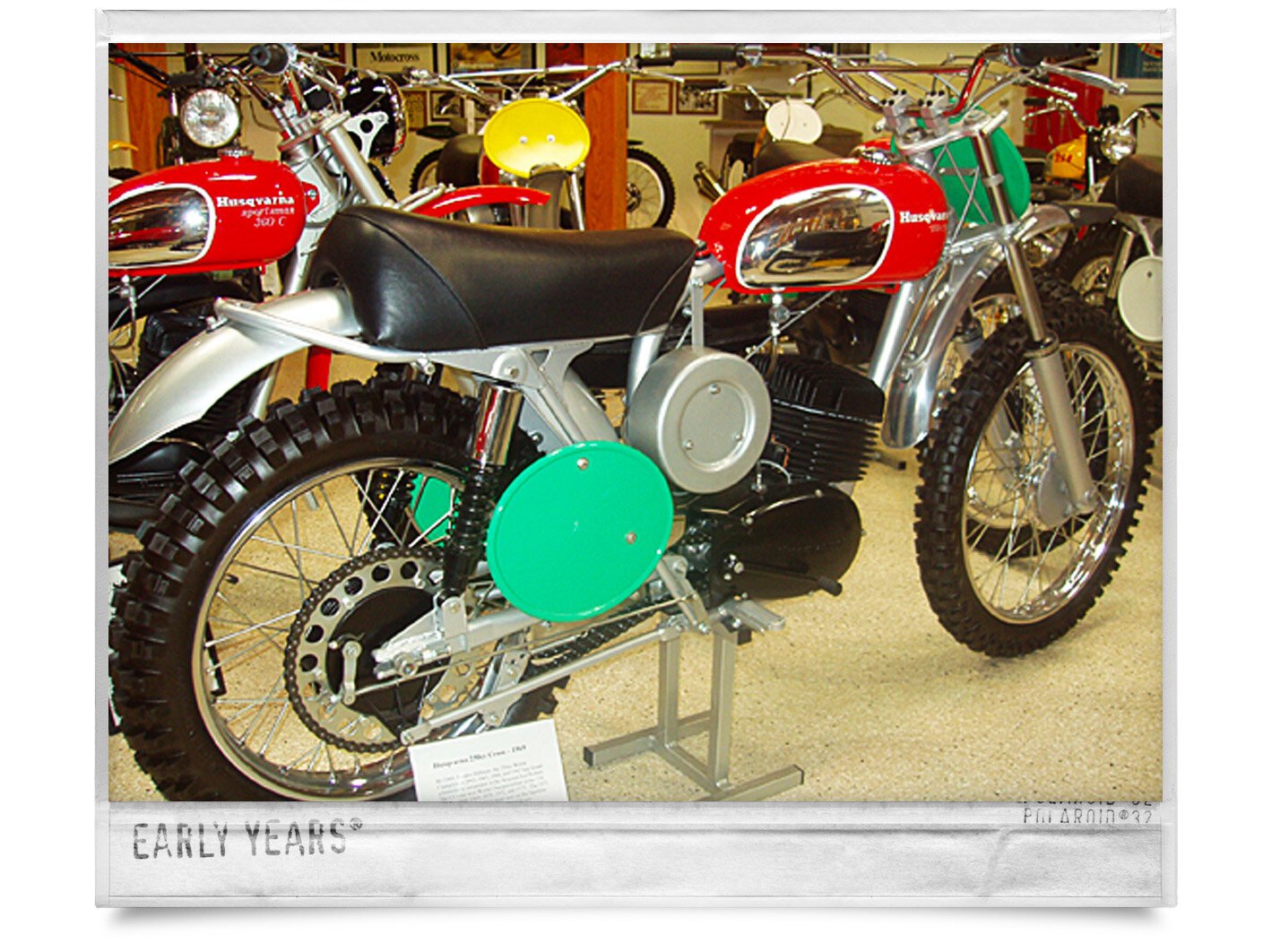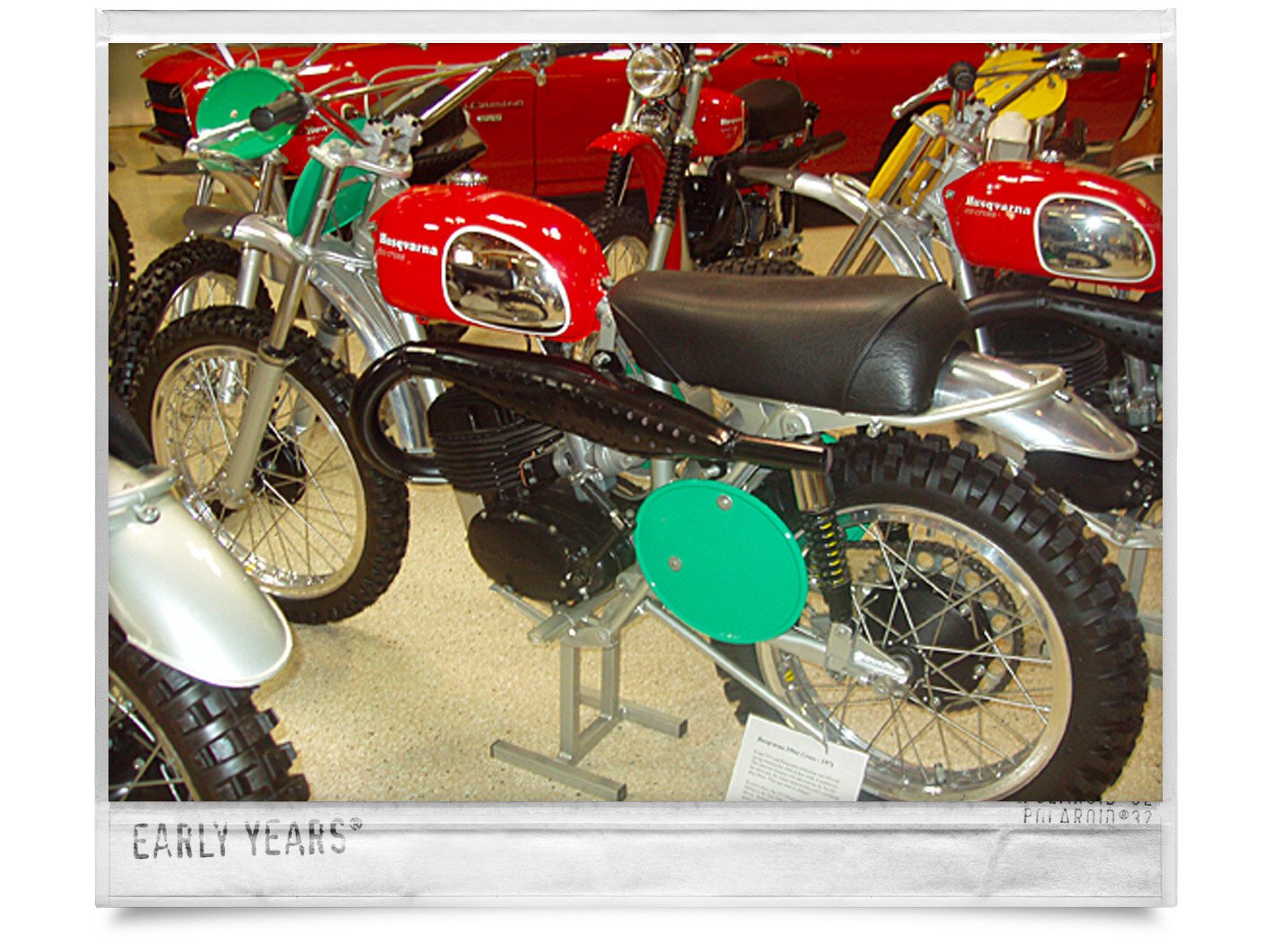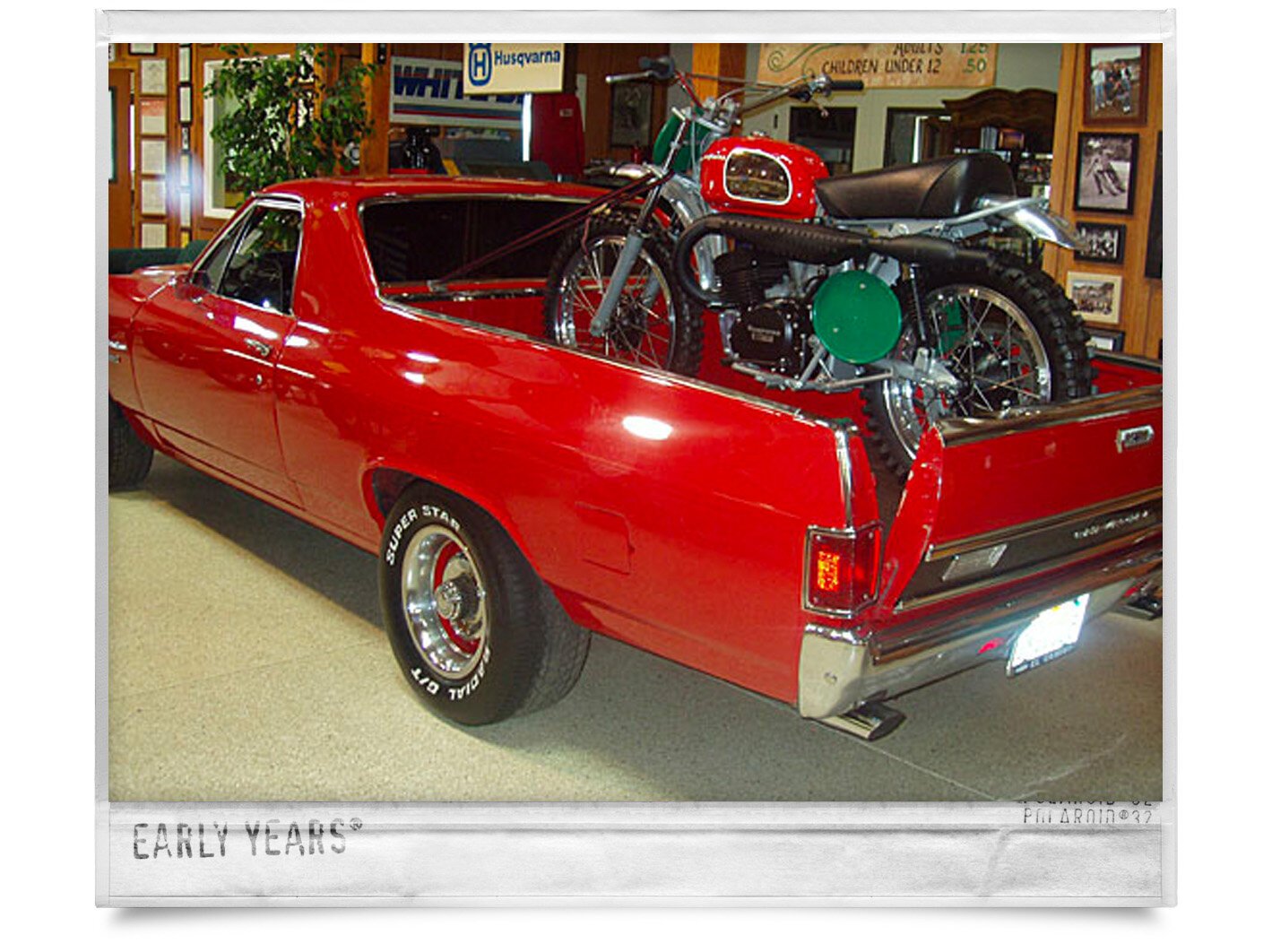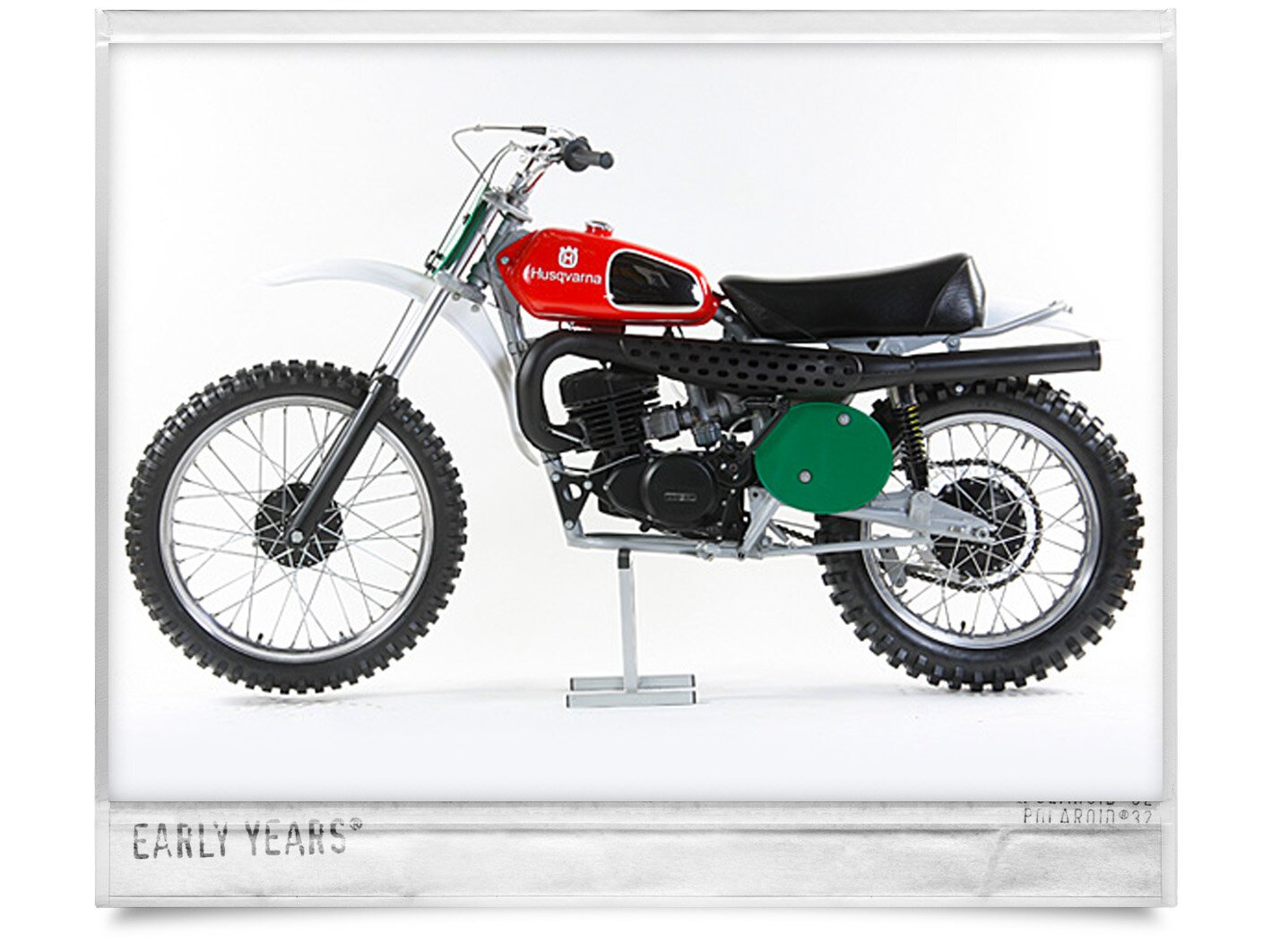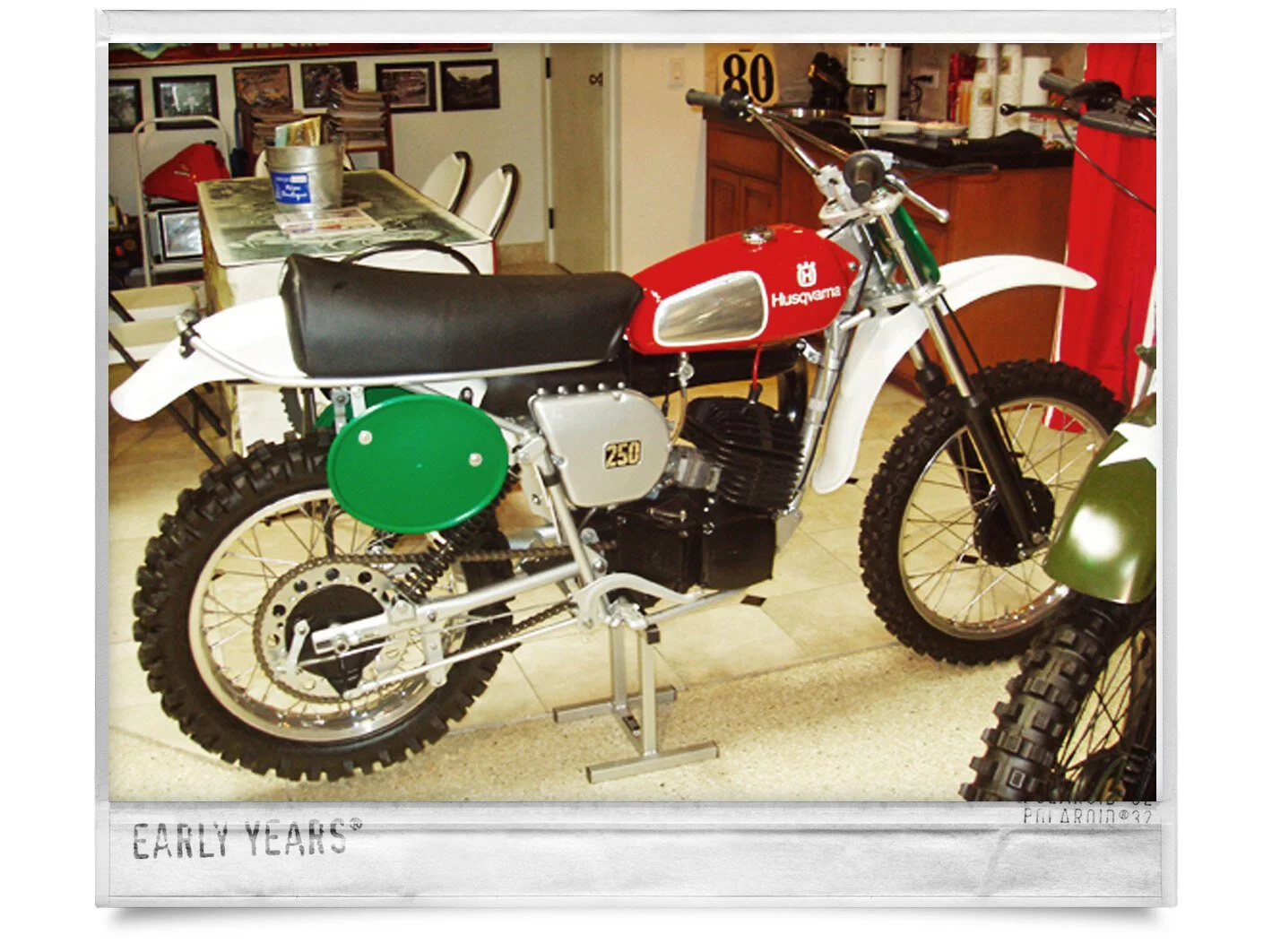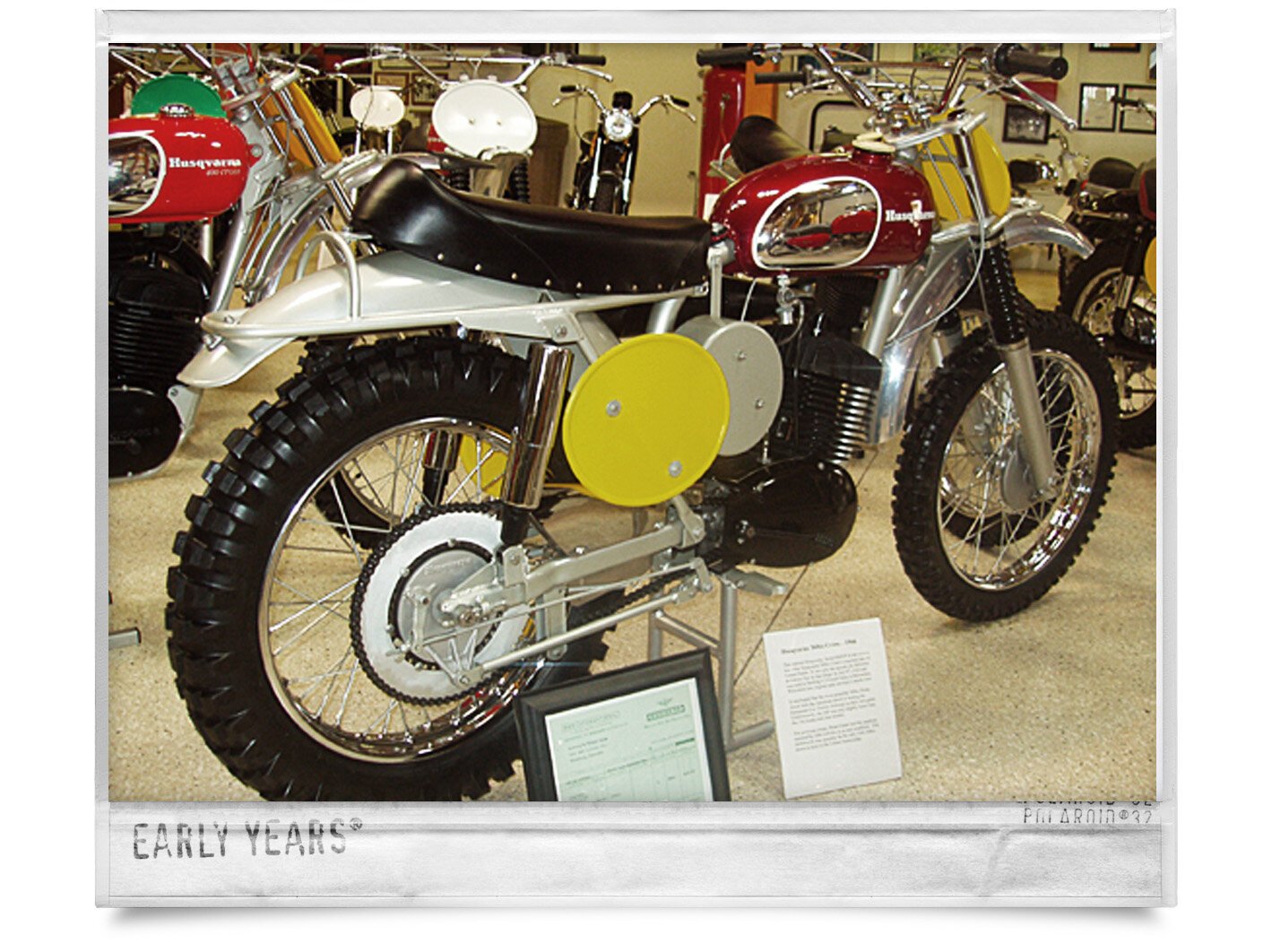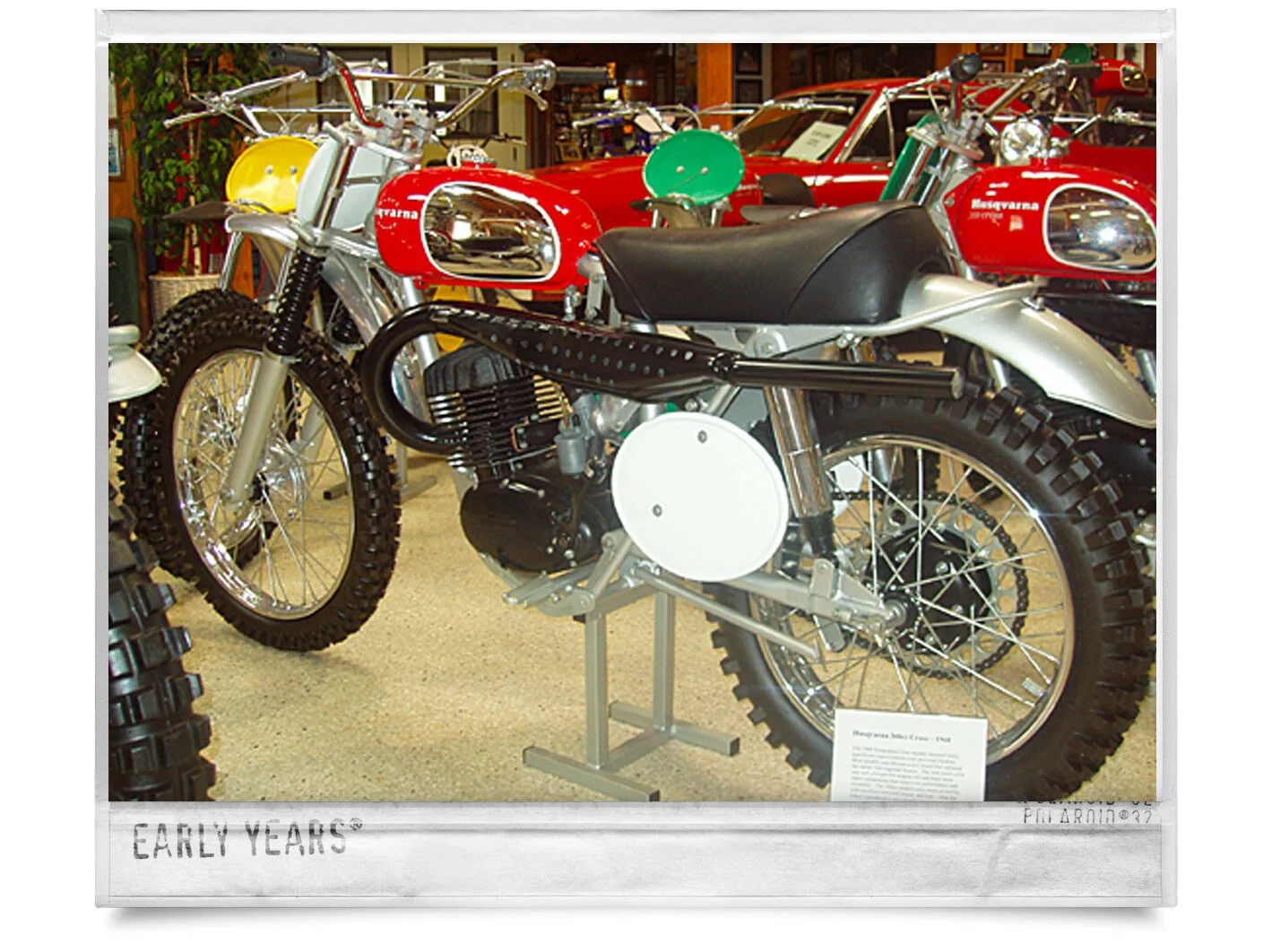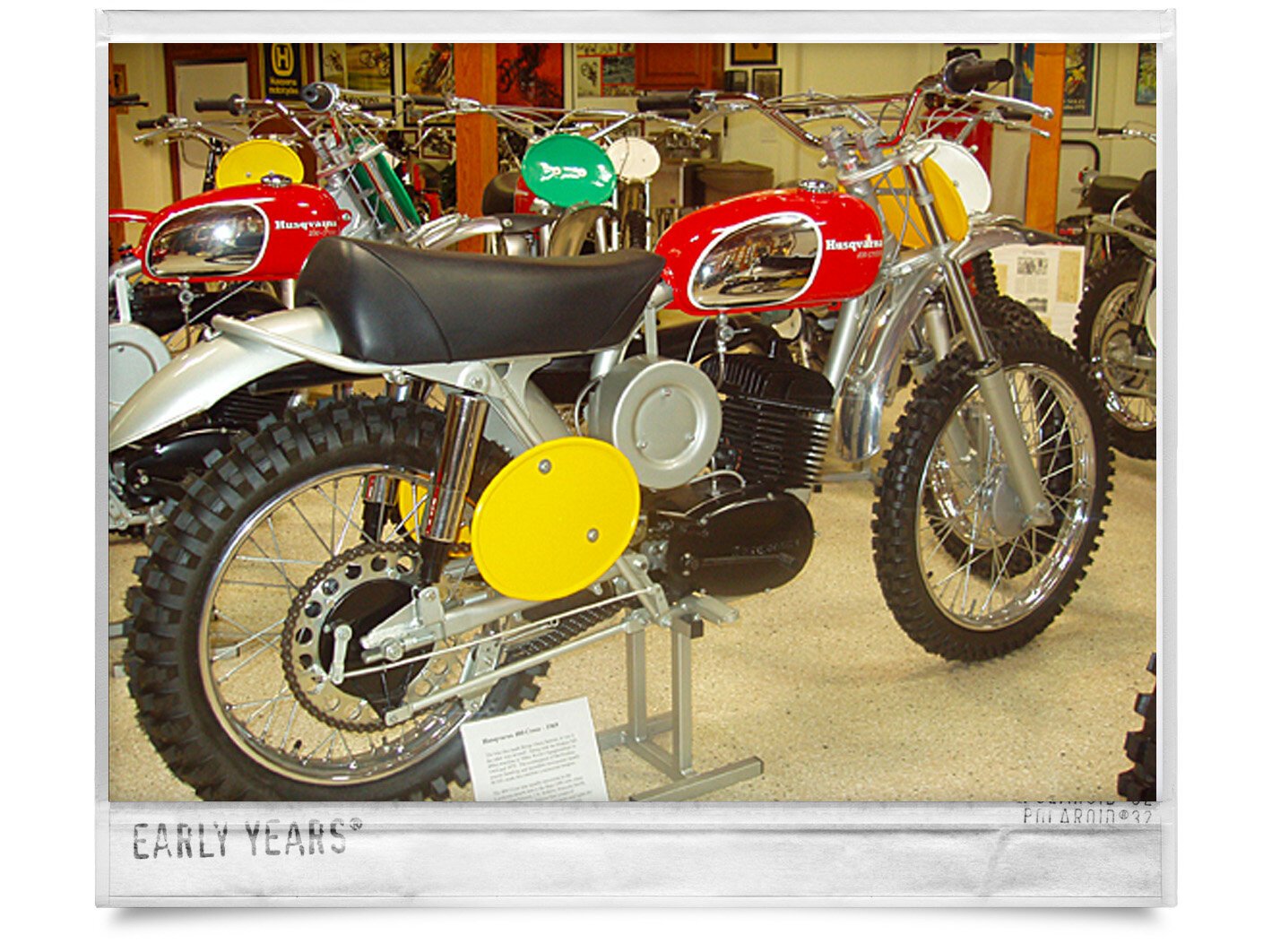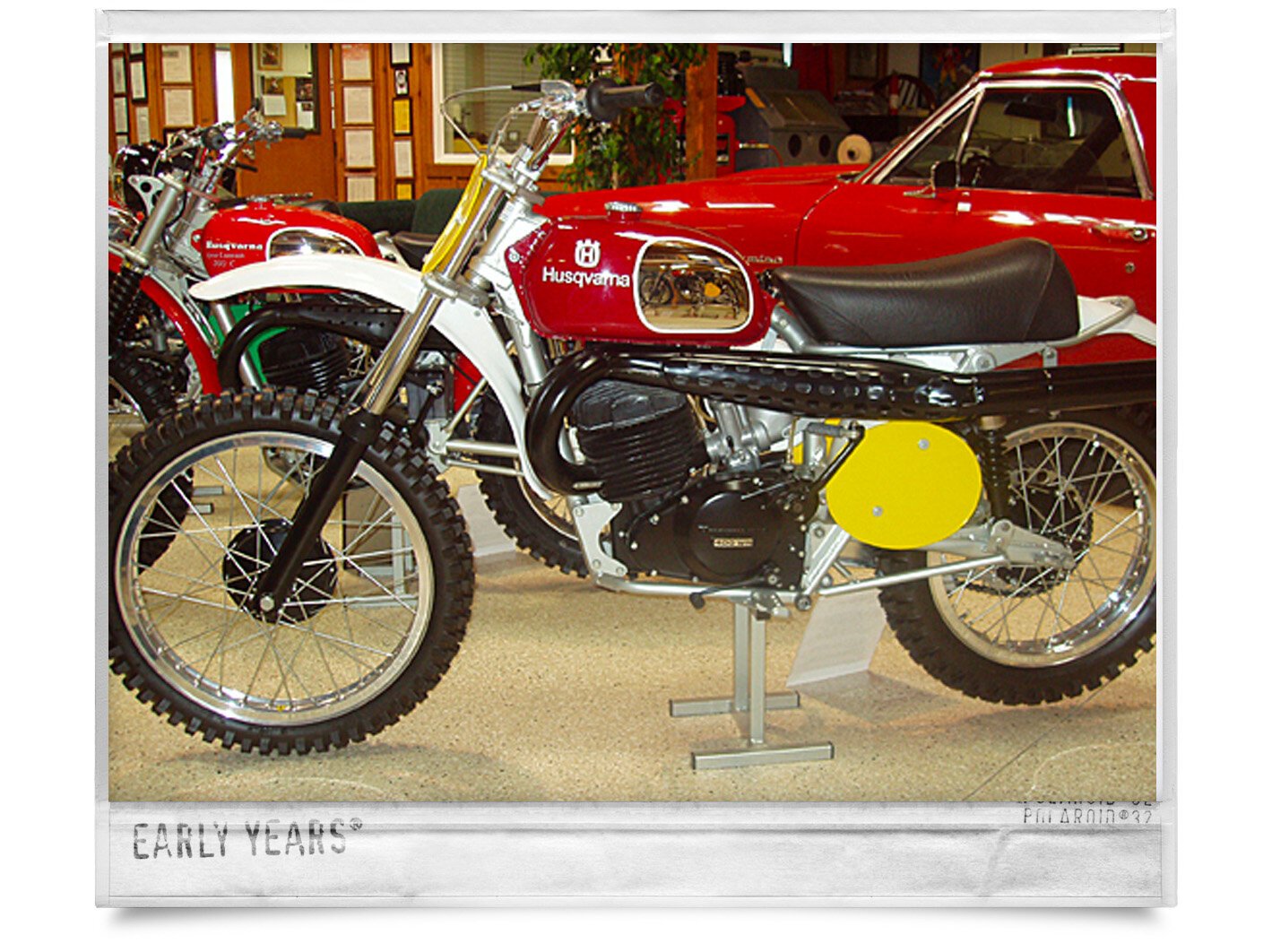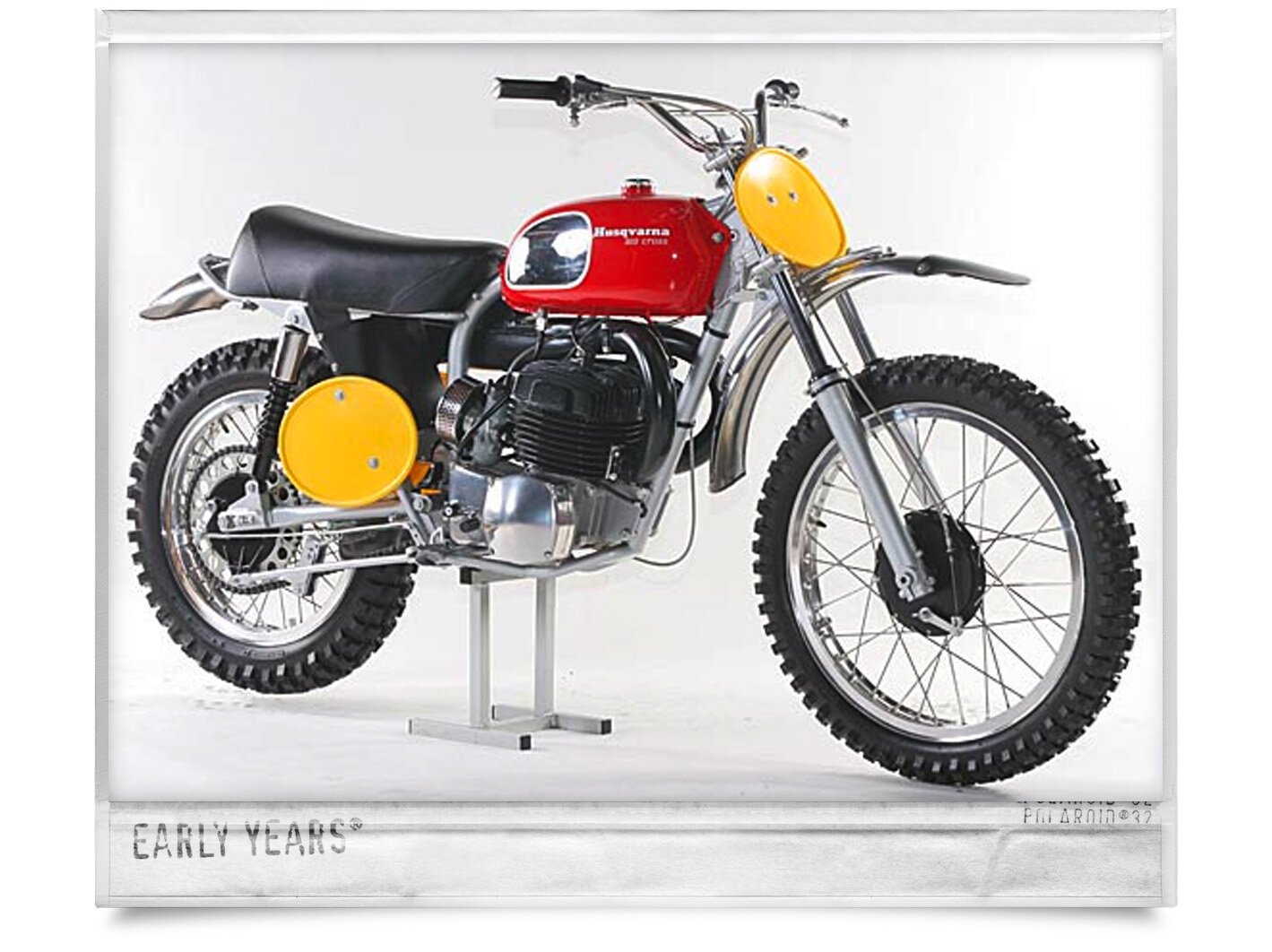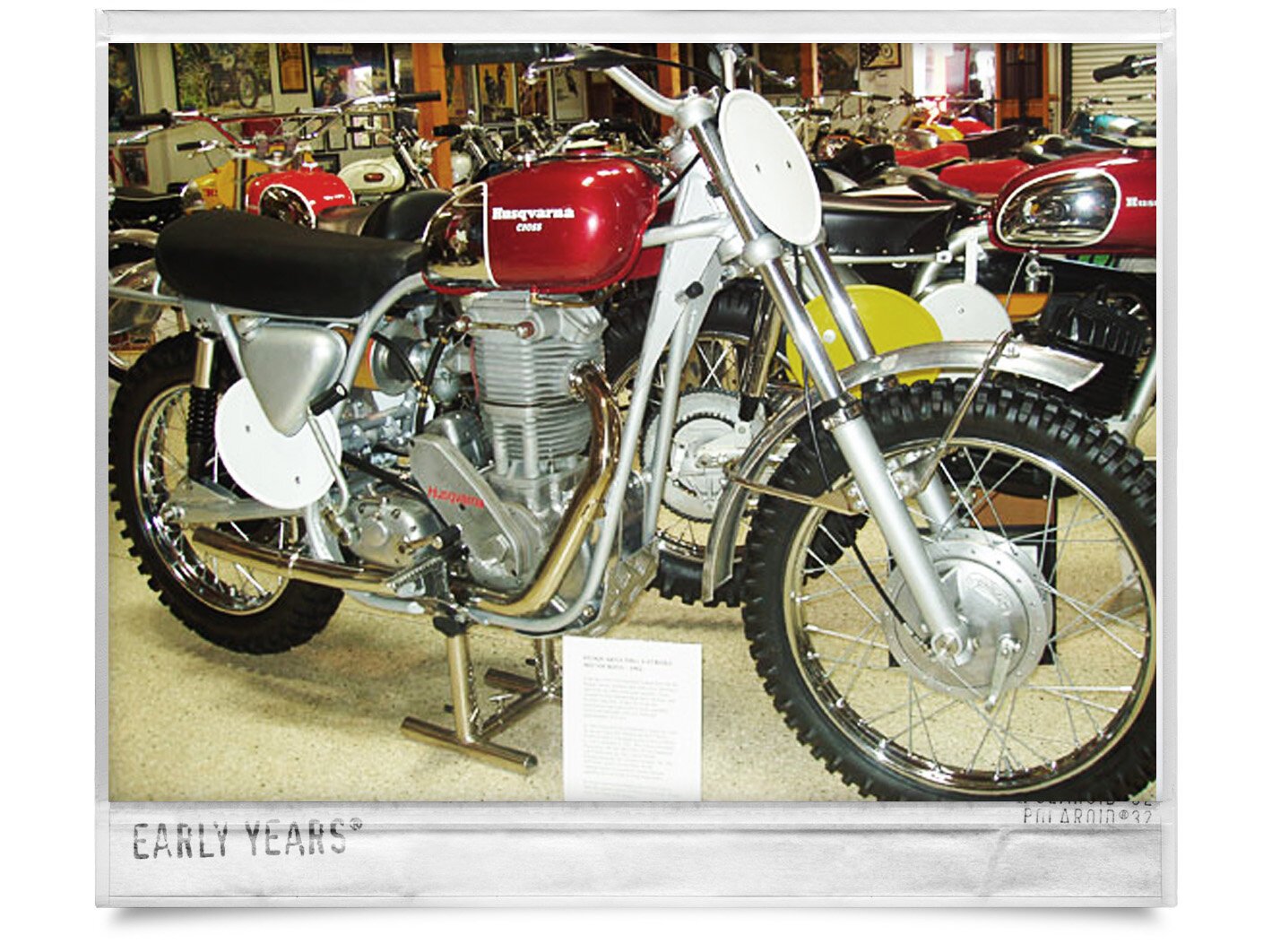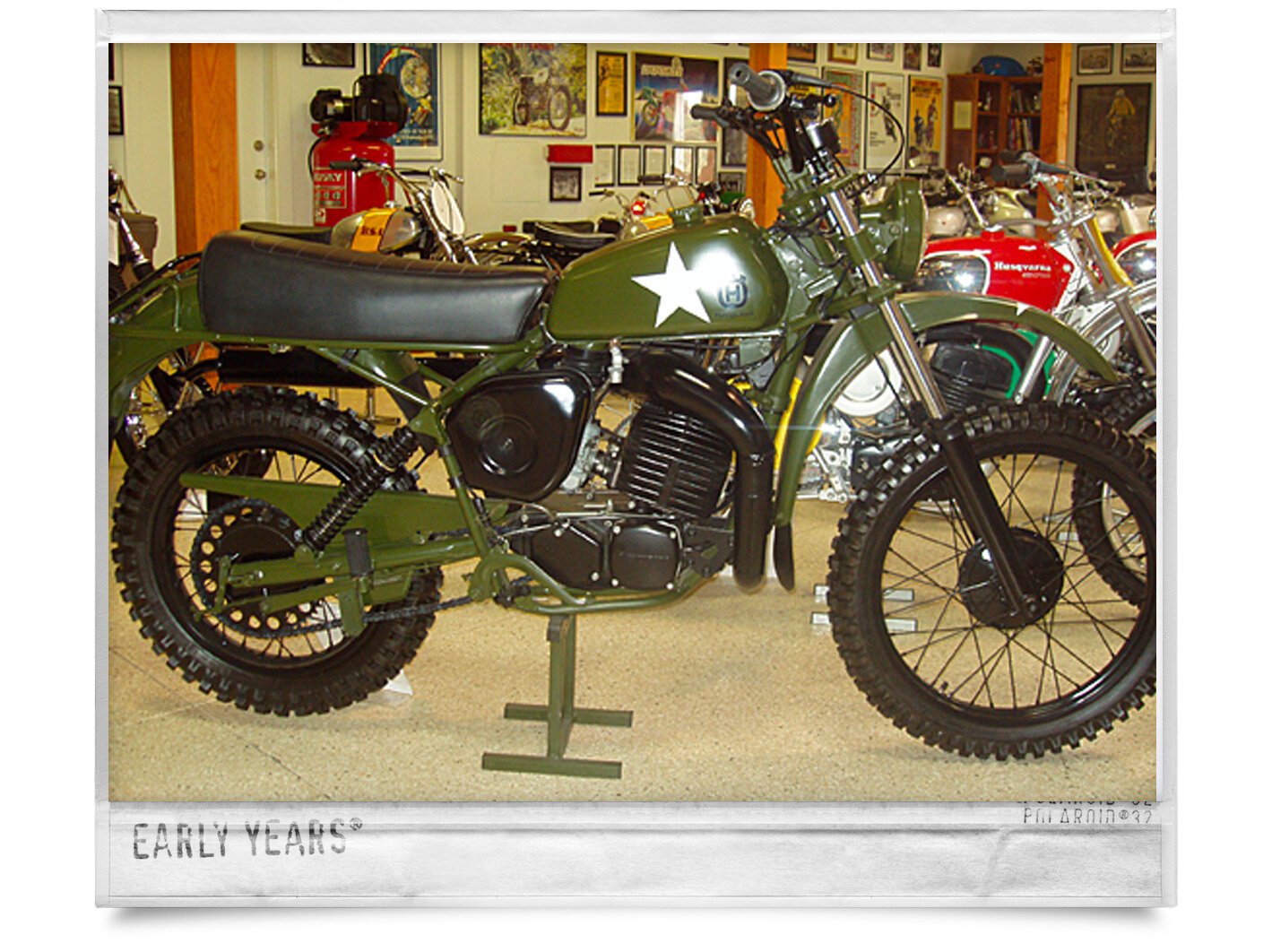Huskqvarna 125cc Cross (1974)
The Husqvarna 125CR was produced from 1972 until 1985. It was often hard to tell one model year from another and this example sports 1974 engine numbers in a 1973 frame. Even more confusing, the gas tank logos changed in font and color between 1973 and 1974. What is true is that at the time of its release the Husqvarna 125CR was the most expensive 125 motocross bike a rider could buy. Unfortunately for Husky, it was released at almost the same time as the first Yamaha YZ125 (and only preceded the Honda CR125 by a short period of time).
Husqvarna suffered the same fate as many of the other European motocross bike manufactures as the Japanese machines kept getting better and better. In 1987 the Swedish brand was sold to Cagiva and production was moved to Italy. In 2009 BMW purchased the brand from Cagiva and the brand is becoming a premier brand once again.
This beautiful machine was restored by Frans Munsters, a Dutch collector and restorer.
Husqvarna Silverpilen 175cc MC-28E / 1960
When Husqvarna introduced the 175cc Silverpilen in 1995, Swedish young men were drawn to this lightweight and racy looking machine. The black and red paint job along with generous use of lightweight alloy components was a good base, and soon a healthy aftermarket for accessories would develop.
The lightweight (165lb) machine with a mere 9.5HP output was a perfect starting point for many tuners and the Silverpilen would receive many modifications aimed at either road racing or motocross. Gote Lindstrom was one of the young tuners that developed a reputation for his “hot rod” parts for the Silverpilen. By 1959, Lindstrom had developed a 250cc cylinder, high compression cylinder head, modified crankshaft, larger 32mm Bing carburetor, and an expansion chamber exhaust. Another Swede – Gustav Flink also built intake manifolds, cylinders, and heads for the machine, but took it another step farther by building a 250cc engine that would bolt into the stock Silverpilen chassis.
Both Lindstrom and Flink would go on to manufacture their own motorcycles; similar in many ways to the Silverpilen, but with 4-speed transmissions (instead of the 3-speed), 250cc engines, double cradle frames, and improved forks and shocks.
Future World Champions Torsten Hallman and Rolf Tibblin would get their racing careers started on modified Silverpilens. Husqvarna started taking notice and by 1963 had incorporated many of the tuners ideas into the new 250 cross models. Stronger frames and sub-frame sections, telescopic forks, Girling shocks, and a full 250cc engine would become standard.
Husqvarna 250cc Cross / 1966
Edison Dye’s vision was to see European Moto-Cross become as popular in America as it was in Europe. In February of 1966 he imported two motorcycles, one of which would go to the legend, Malcolm Smith. By the fall of 1966, he had convinced Husqvarna to allow the then, 3-time World Champion Torsten Hallman to race in a series across American that would showcase Torsten (and the Huskies) abilities against the best riders in America.
Torsten Hallman was undefeated in 22 straight motos, often lapping the field in what would be the first Inter-Am series.
This example, one of approximately one hundred 250cc Cross’s imported and sold in 1966 was restored by collector Mike Owens. Note that the 1966 had a 19” front wheel, small crankcases, and bolt together frame. 1966 and 1967 models also were painted a burgundy color.
A handful of pre-1966 Husqvarna’s made their way to America, but 1966 was the first year that they were imported in significant numbers.
Husqvarna 250cc Cross / 1969
By 1969, Torsten Hallman, the 250cc World Champion in 1962, 1963, 1966, and 1967 had found a formidable competitor in the Belgium Joel Robert. The CZ rider won World Championships in the 250 class in 1968, 1969, 1970, 1971, and 1972. The 1971 and 1972 Championships were won on the Japanese Suzuki RH. To this day, Torsten and Roger DeCoster consider Robert to be possibly the most talented motocross racer of all time.
In America, sales for the 250 Cross model were robust, as you could race this machine out of the crate with little or no modifications. Edison Dye picked only quality dealers to sell his Swedish Iron and demanded that they stock adequate parts supply to assure the riders and racers wouldn’t miss important events. I’m sure this contributed to the sales success.
This machine was meticulously restored by Bill McNees to better than new. Bill is one of the for-most restorers of Huskies, as his bikes have won the Del-Mar Concours several times. They don’t get any nicer than this example.
Husqvarna 250cc Cross / 1971
It was 1971 and Husqvarna motocross and off-road racing motorcycles were at their peak in popularity. The Japanese invasion was just coming on, but for the most part, the Asian imports were still considered play bikes. This was soon to change!
In many ways, the 1971 Husqvarna 250cc Cross was similar to the first 1966 model that hit American shores. Refined for durability, they still had a 4-speed transmission, the engine was almost identical in appearance, aluminum fenders replaced the steel fenders, and Akront alloy rims saved weight and were stronger than the predecessors steel rims. In function, the Huskies still shifted on the right while most of the competitors had moved shifting to the left. Much was to change the next year as Husqvarna tried to retain it’s position as the top motocross machine.
This machine was restored by Noble Butler to it’s original condition.
Husqvarna 250cc Cross (1972)
The 1972 250cc Cross was a completely new and redesigned motorcycle after years with no significant changes in the Husqvarna offerings. The engine now shifted on the left, like other European and Japanese machines, had an all new 5-speed transmission, and was considerably heavier than its predecessors. It’s rumored that several of the Husqvarna team riders actually refused to ride the new 5-speed models, and instead, rode the previous year’s model. They found the new engine less powerful, and for off-road, preferred the 8-speed (4-speed with hi/lo range) gearbox from the 1971 machine.
Fortunately for Husqvarna, due in large part to the success of the movie “On Any Sunday” that featured Malcolm Smith and Steve McQueen riding Huskies, sales continued to climb.
Purchased from my friend Mike Eber, the completely original machine was restored by Vintage Iron. It sits in the back of my son Brad’s prize 1970 Chevrolet El Camino. We hope and pray that Brad will someday take the Husky out to the desert for a ride in his beloved El Camino.
Husqvarna 250cc CR MAG / 1974
When Husqvarna first introduced the all new 5-speed models in 1972, most riders detested the heavier weight and poor performance of the new machines. This was all rectified in 1974 with the introduction of the 250 Mag model.
The Husqvarna factory had listened to the owners complaints and the new model featured magnesium (much lighter than aluminum) components throughout the machine. The engine center cases were even cast out of magnesium and the result was a much lighter machine. Performance was addressed with an all new reed induction engine that delivered stellar performance. The frame also received mods that improved the strength and suspension travel.
The 1974 250 CR MAG was and to this day….is considered by many as the best Husqvarna ever built. This example was restored to showroom new condition and purchased from the Brad Morrison collection. Enjoy!
Husqvarna 250 CR / 1976
INFO COMING SOON.
Husqvarna 360cc Viking (1966)
Two-strokes made their first impact in the 250 class, where the woefully underpowered four-strokes quickly succumbed to the light weight and snappy response of the 250 offerings of CZ, Greeves and Husqvarna. But the naysayers claimed that two-strokes would never dominate the 500 class, for three reasons:
(1) The limited metallurgy of the day wasn’t conducive to two-stroke longevity (and a bigger piston only meant a shorter lifespan).
(2) A 500cc four-stroke could pump out more horsepower than a 360cc two-stroke.
(3) BSA, who owned the 500 World Championship, was ready to unleash titanium frames, ultra-lightweight engines and Jeff Smith on the horde of ring-dings.
Husqvarna had historically been part of the four-stroke power elite. Swede Rolf Tibblin had won the 1963 500 World Championship on a specially built Husky thumper that was never put into production. In 1963, the best two-stroke was in ninth place and no two-strokes finished in the top ten in 1964. It wasn’t until 1965 that the first two-stroke appeared on a 500cc podium when Czech-built CZ’s were second and third behind Jeff Smith on the four-stroke BSA. One year later, CZ-mounted Paul Friedrichs and Rolf Tibblin won nine of 14 500 GPs between them, signaling the end of four-stroke dominance.
Where was Husqvarna? They had pulled out of the 500 class to concentrate on building a competitive 250cc two-stroke for Torsten Hallman. That move paid off with back-to-back 250 World Championships in ’66 and ’67. Husky then used its 250cc development program to launch the 1966 Husqvarna 360 Viking. The Open class Husky was based on Torsten Hallman’s 250. Its 78.5mm by 72mm bore and stroke engine pumped out 37 horsepower (according to the brochure) via a 32mm Bing. As it sat, the 1966 Husky 360 weighed only 215 pounds.
This special Husqvarna, Serial #66939 is one of only ten, 1966 Husqvarna 360cc Vikings imported into the United States. It was only the second one delivered to Edison Dye in San Diego on July 6th, 1966 and was sold to Hertting’s Triumph Sales in Milwaukee, Wisconsin (see original sales invoice) a month later.
The previous owner, Brian Grade had this machine restored by John LeFevre to as new condition. This motorcycle may possibly be the only 1966 360cc know to exist in the United States today.
Husqvarna 360cc Cross / 1968
The 1968 Husqvarna Cross models featured many significant improvements over previous Huskies. Most notably was the one-piece frame that replaced the earlier bolt-together frames. The tank paint color was now a bright fire-engine red and there were many refinements that improved performance and reliability. The 360cc models were more powerful, with excellent low-end torque, and had – what the riders considered a very useable powerband.
The 1967 Inter-Am series had been a spectacular success, and Edison Dye could sell every Husqvarna Cross he could get his hands on. The 360cc models were especially popular in the deserts of America, thanks to riders like Malcolm Smith and J.N. Roberts who were dominate in the long and fast off-road races.
The example you see here was restored by my friend Noble Butler back to assembly-line new condition.
Husqvarna Enduro 360cc Sportsman / 1969
Edison Dye convinced Husqvarna management to build a street-legal machine similar to the motocross models that were selling so well in the Americas. 1969 was the first year that Dye was able to import this model in large volume and the Sportsman was intended to compete with the Yamaha DT1-250 and other offerings from the Japanese.
Malcolm Smith showcased this new machine by riding it, and Gold Medaling in the International Six Day Trials in Spain. Unfortunately, sales never took off for this very special machine. Rather high tech stuff – like the 8-speed hi-low range, and a rather high retail price contributed to the poor sales.
This example was restored by my friend, Bill McNees back to factory original. It’s been shown once at the Del Mar Concours where it won best in class.
Husqvarna 400 Cross / 1969
The bike that made Bengt Aberg famous, or was it the other way around? Aberg took the Huskies full 400cc machine to 500cc World Championships in 1969 and 1970. The combination of the Huskies precise handling and incredible horsepower (nearly 40 HP) made this machine a motocross weapon.
The 400 Cross was equally successful in the California deserts and in the Baja 1000 with riders like Gunnar Nilsson, J.N. Roberts, Malcolm Smith, and Whitey Martino. Edison Dye’s team of mechanics would mount large gas tanks and lights for the torturous Baja and the Husqvarna reliability would assure a good finish.
This example, built for me by Husqvarna expert, John LeFebre could almost be considered a new motorcycle. Over 50% of the parts used in the restoration were NOS (new – original stock) parts.
Please enjoy this excellent example of the Husqvarna golden years.
Husqvarna 400 Cross / 1970
Is this the Husqvarna 400 Cross that Malcolm Smith rode on the Baja beach in the movie “On Any Sunday?” Well……..no! But he rode one very similar to this example. Husqvarna was riding high and guaranteed more good karma with the introduction of this motorcycle documentory that was produced in 1970.
Arguably the most popular model ever produced by Husqvarna, this machine was the choice for many off-road racers included the actor Steve McQueen. Fast, excellent high speed handling, light-weight, and reliability were praises often sung by its owners.
How did I end up with so many Husqvarna’s? “They kinda find you,” is the answer to that. People find out you’re a collector of well restored Huskies and, if I don’t have that example, I get weak and make the purchase.
Please enjoy this well restored “On Any Sunday” bike. It’s as new on the inside as it is on the outside!
Husqvarna 400cc WR “Wide Ratio” / 1974
By 1974, Husqvarna had lots of competition in the off-road market. Honda had the Elsinore, Yamaha the MX and YZ models, Suzuki had the TM, and Kawasaki was selling the KX models. They – Husqvarna, sharpened their tool, so to speak, with this 6-speed, wide ratio gearbox model. Others features of the WR included a larger tank (than CR models), plastic fenders, and a much quieter muffler. Applause! They were ahead of their time with a quieter bike.
In the desert, with riders like A.C. Bakken, Brent Wallingsford, and Larry Roeseller, Huskie was still winning lots of races.
It’s interesting that Husqvarna chose to go back to the Burgundy colored fuel tank that they had abandoned in 1968.
This bike was restored to “as new” condition by Noble Butler.
Husqvarna 500cc Twin “Baja Invader” / 1969
If one cylinder is good, then two must be better! Or so thought Husqvarna engineer Ruben Helmen in 1966 when he designed production 250cc motocross components into a horizontal twin-cylinder engine. Without any major funds from his employer, he designed crankcases that could easily be cast by Husqvarna for mainstream production.
The motocross testing was handed over in 1968 to R&D rider, Rolf Tibblin and subsequently to 4-time World 250cc Motocross Champion Torsten Hallman. Hallman first raced the Twin on spiked snow tires before concluding that this was definitely no motocrosser. The engine was too wide, even though it was extremely fast. Unfortunately, the 500 Twin never made it to production and only one motocross/offroad version was ever built.
Baja Invader wins Baja 1000
In 1969, the 500 Twin was raced in the 5 European F.I.M. Cup motocross by Husqvarna rider, Gunnar Nilsson. The series, primarily to retain interest in the 501cc to 750cc sector that featured outmoded British 4-stroke iron, was easily dominated by Nilsson and the powerful Husky Twin. Fresh from this success, the bike was shipped to U.S. importer, Edison Dye. Edison’s vision was for this powerful machine to race the Baja 1000, one of the most grueling races on the earth. Riders, Gunnar Nilsson and J.N. Roberts were selected to pilot the machine. With speeds around 110mph, the 500 Twin won the 1969 event by 20 minutes. It was raced in several other events in 1970 and 1971 and then laid to rest in Dye’s warehouse for over 20 years.
Massive Motor
From the side, it’s very difficult to see the difference between the Twin and other early Husqvarna’s. Oh, but from the front or top, one is overwhelmed by the size, especially the width of the engine. This ex-Baja 1000 winner is the only Husky twin dirt bike ever built. It remained in Edison Dye’s former Husqvarna warehouse until 1998 when Dutch enthusiast, Frans Munsters purchased the bike and restored it meticulously to original specification. It now resides at Tom White’s Early Years of Motocross Museum.
Specifications
Engine: Piston port, 2-stroke twin, 490cc(69.5 x 64.5mm), 4-speed transmission
Power rating: 60hp @ 6500 rpm
Fuel System: 2 Amal Concentric 1 1/8”
Suspension: Husky telescopic forks-35mm, swingarm rear with Girling Shocks
Wheels/Brakes: 21” front w/drum brake, 18” rear w/drum brake – Akront rims
Weight: 265 lbs-dry
In reality, only 10 engines were ever built, with two going to road racer Bo Grannath, seven to European sidecar racing, and the Baja Invader.
Husqvarna 500cc 4-stroke Motocross / 1962
In the late 1950’s Nils Hedlund worked first with the Monark factory and then later with Lito to develop a start of the art 500cc motocross machine. Some similarities exist between these early machines and the BSA Gold Star. In fact, the Gold Star transmission was used in these exotic machines. Only 6 true Monarks were ever built and approximately 30 Lito’s.
In 1960 Husqvarna hired Hedlund to build race bikes for factory riders Bill Nilsson and Rolf Tibblin. Hedlund build 10 complete machines from 1960 to 61 and 6 machines in 1962. Bill Nilsson rewarded Husqvarna with the 1960 500cc World Champion and Tibblin won the 1962 and 63 World Championship for the Swedish marques. By 1964 Jeff Smith would win the 500cc World Championship on a smaller 4-stroke machine signaling the end of the 4-stroke behemoths!
In recent years several replicas have been built in Italy that appear correct in nearly every detail. Please enjoy this hand-built machine.
Husqvarna 250cc – U.S. Military Model / 1976
U.S. Army joined the off-road motorcycle revolution and ordered approximately 100 of these automatic transmission Huskies. The rear rack would support radios, extra fuel, or ammunition and accessory mounts could be added for rifles or automatic weapons. As you can see, the color was Army green and black – no chrome here as reflections could be seen afar.
Wish I had some great battle stories to tell you, help me out if you know some, but as far as I know the Husky Military Model was not responsible for winning any wars. The fact that the U. S. Army purchased the Swedish motorcycle helps confirm the popularity the Huskies enjoyed at the time.
This bike was meticulously restored by Noble Butler back to original – U.S. Army specifications.

